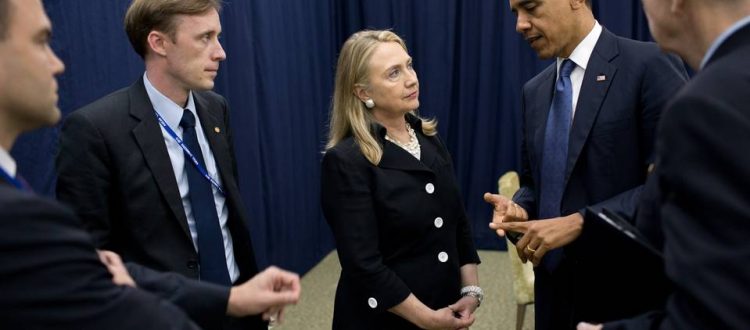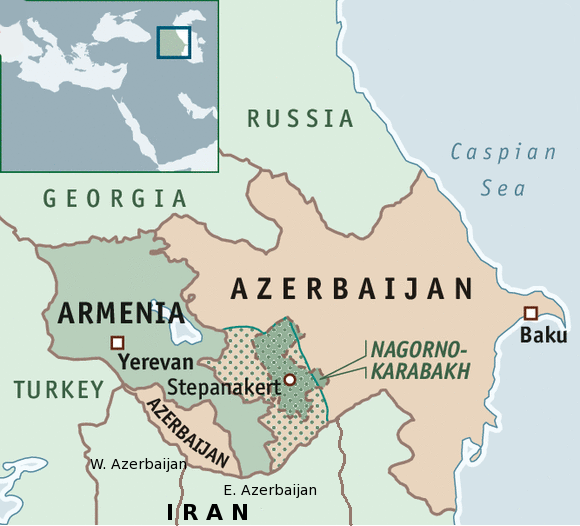President-elect and a safer south Caucasus?
Whilst we don’t yet know what policies a Trump administration will ultimately pursue, one can say with little apprehension that, based on Clinton’s philosophies, the Southern Caucasus may well be spared the horror of recent US policy towards the Middle East.
| Suggested Reading | Conflict Background | GCCT |
By David Davidian
It is not that US President-elect Trump is a peacemaker, but a Hillary Clinton presidency would have added to world conflict. At a minimum, Clinton would have imposed a Syrian no-fly zone, the implications of which, unlike Libya, would not have been Clinton again boasting, “We came, we saw, he died,” personifying Julius Caesar’s “I came, I saw, I conquered.” Then there is Iran, the remaining Middle East country on The Project for the New American Century’s (PNAC) target list that included North Korea, Iraq, Iran, Libya, and Syria. An 80% Middle East threat-to-success ratio is impressive.
What would it take if Clinton determined it was Iran’s turn to be put on the neocon/interventionist chopping block? An easily digested excuse could be generated within a backdrop of worsening tensions between major players in the region, such as Saudi Arabia, Israel, to a lesser extent Turkey, and the arc of influence Iran projects between Tehran to the Gaza strip.
Clinton said about the P5+1 agreement between United Nations Security Council’s five permanent members (China, France, Russia, UK, the US, plus Germany) and Iran, “I don’t see Iran as our partner in implementing this agreement. I believe Iran is the subject of the agreement,” yet she takes credit for creating a diplomatic success for Obama. Clinton’s statement does not generate any sense of leadership or even goodwill. Iran is set equal to a pair of shoes. Combined with other bellicose statements by Clinton, such as, “They need to understand that America will act decisively if Iran violates the nuclear agreement, including taking military action if necessary,” a clear direction was established.
To be fair, US President-elect Trump has made statements about his opposition to Iran’s nuclear program and has stated the P5+1 agreement needs to be re-negotiated. A re-negotiation is infinitely more desirable than a call to arms.
Map of the South Caucasus Region
What does this mean for conflict in the South Caucasus region between the Black and Caspian Seas? When it became clear there may be a P5+1 negotiated agreement, Israel began the process of letting it be known it was prepared to “go it alone” with Iran. Regardless of being political posturing or not, one of the areas where Israel initiated this process was in the Republic of Azerbaijan, which shares a border with Iran. Israel has an interesting synergistic relationship with Azerbaijan. Almost half Israel’s crude oil comes from Azerbaijan, and Azerbaijan buys its highest technology weaponry from Israel, especially offensive and defensive Unmanned Aerial Vehicles (UAVs), including high-attitude surveillance drones. In 2012, reports began to emerge of secret agreements allowing Israel to use bases in Azerbaijan for the express purpose of forward-basing weaponry to be used against Iran. Of course, Azerbaijan denied the existence of such agreements, and denied spying against Iran. However, such activity caught the eyes of US officials considering Israel-supplied Gabriel anti-ship missiles would be used against Iran, doubtfully against Russia, being Caspian littoral states.
Of concern would be the nationalist awakening of Iranian Azerbaijanis, of which about 18 million live immediately south of Azerbaijan, Armenia, and to the east of Turkey (see above) map. Iranian Azerbaijanis are part of the greater Iranian cultural identity. The same can be said of Azerbaijan’s population only a century ago. It wasn’t until the very late nineteenth century and early twentieth century that intellectuals in Baku tilted toward a Turkish social orientation as opposed to an Iranian one, although much of the region has been under Russian colonial administration for a century. With the influence of Ataturk and Lenin, Soviet Azerbaijan continued with its Turkic orientation. In contrast, for the people in Iran’s regions of East and West Azerbaijan, Iranian orientation was state policy.
One vehicle by which aggression against Iran could proceed is to foment a sense of unified Turkic nationalism between Baku-administered Azerbaijan and Iranian Azerbaijan. Not that a union of these peoples would be the design goal, but rather, it would be used as a tool against a unitary Iran. While this seems rather far-fetched, as a military option, it is not unreasonable. Although the text is probably restricted (thus unverified), a quick glance at a map of a US military plan for the invasion of the ex-Soviet republics of the Caspian hydrocarbon basin shows this plan was part of a post-Iran invasion drawn up during Bush’s second term.
Given Turkish incursion into both northern Syria (while clearly having allowed personnel and supplies across its border in support of anti-Assad forces) and its forces currently stationed just outside of Mosul, Iraq, ostensibly in support of the local Sunni population, Turkey would surely participate in such a plan to emasculate Iran, considering the kinship of Turkey, the Republic of Azerbaijan and the Turkish-speaking population of far northwest Iran. Such an operation would be an imminent existential threat to Armenia. Even if the Republic of Armenia were to totally abstain from military involvement it would undoubtedly have to endure a full Azerbaijani-forced depopulation of neighboring Nagorno-Karabakh, creating 150,000 Armenian refugees flooding into Armenia. Azerbaijan would undoubtedly attempt to capture all of south Armenia and unite it with their exclave of Nakhichevan. Turkey would surely destroy as much of Armenia’s infrastructure as possible forcing what remains of Armenia into the stone age or worse.
If Armenia is able to use what weaponry it has against the combined forces of Azerbaijan and Turkey, at least destroying Baku’s hydrocarbon and transport infrastructure, it surely would be attacked in kind.
So what might Russia, or to a much lesser extent the Collective Security Treaty Organization (CSTO), do in such a scenario? Last April’s Four-Day war between Azerbaijan and Armenian forces in Nagorno-Karabakh put into serious question the effectiveness of the Russian-sponsored CSTO, after member states Kazakhstan released a statement of neutrality and Belarus declared that the conflict should be resolved based on territorial integrity. Russian statecraft might decide not to immediately interfere with such an Iran operation – not to come to Armenia’s defense, as its interest could be served better otherwise. However, if it felt its interests were in danger it could easily sweep down through Georgia into Armenia. The wars that have ensued in this region for many hundreds of years would be fought today with modern weapons.
Whilst we don’t yet know what policies a Trump administration will ultimately pursue, one can say with little apprehension that, based on Clinton’s philosophies, the Southern Caucasus may well be spared the horror of recent US policy towards the Middle East.
David Davidian is an Adjunct Lecturer at the American University of Armenia. He has spent over a decade in technical intelligence analysis at major high technology firms.
David Davidian is an Adjunct Lecturer at the American University of Armenia. He has spent over a decade in technical intelligence analysis at major high technology firms.
The views expressed in this article do not necessarily reflect those of TransConflict.




















